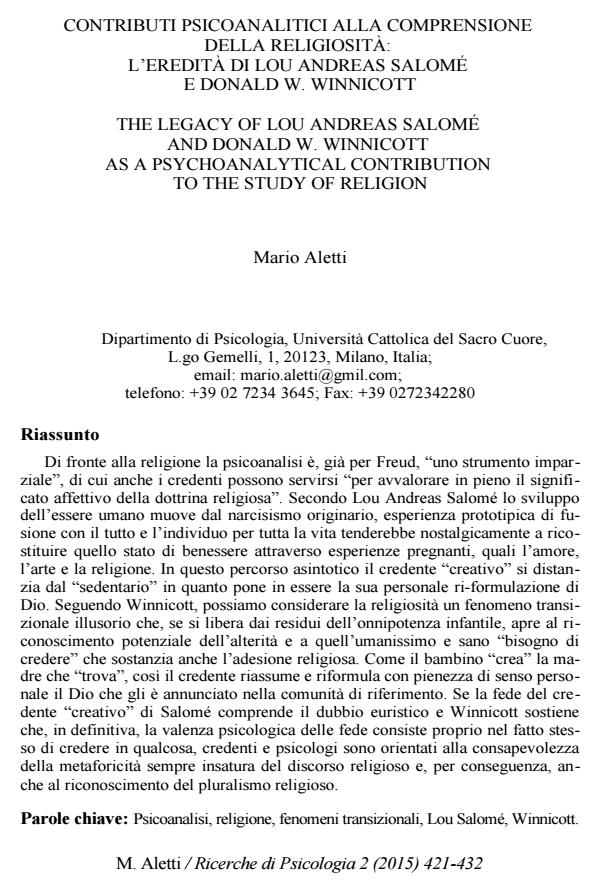The legacy of Lou Andreas Salome and Donald W. Winnicott as a psychoanalytical contribution to the study of religion
Journal title RICERCHE DI PSICOLOGIA
Author/s Mario Aletti
Publishing Year 2015 Issue 2015/2 Language Italian
Pages 12 P. 421-432 File size 156 KB
DOI 10.3280/RIP2015-002010
DOI is like a bar code for intellectual property: to have more infomation
click here
Below, you can see the article first page
If you want to buy this article in PDF format, you can do it, following the instructions to buy download credits

FrancoAngeli is member of Publishers International Linking Association, Inc (PILA), a not-for-profit association which run the CrossRef service enabling links to and from online scholarly content.
For Freud psychoanalysis is "an impartial instrument" also when it comes to religion. "Defenders of religion will make use of psycho-analysis in order to give full value to the affective significance of religious doctrines". Lou Andreas Salome believed that narcissism is an early experience of "oneness with the universe". According to her, man tries all his life, to regain such a state of well-being via creative experiences such as art, love, and religion. As far as religion is concerned, Salome articulates a clear distinction between a "creative" and a "sedentary" believer, since the creative believer - in a certain way - calls into being his God. Winnicott considers religiousness to be an illusory transitional phenomenon, when liberated from the childhood hallucinatory omnipotence; as a child with his mother, a believer "creates" the God he "finds". Since Salome’s "creative" believer’s religious faith encompasses doubt and Winnicott states that, in conclusion, the psychological value of believing is "believing in anything at all", believers and psychologists of religion become aware of the never ending metaphoricity of religious language and, consequently, of the necessity of religious pluralism.
Keywords: Psychoanalysis, religion, transitional phenomena, Lou Salome, Winnicott
- Aletti, M. (1998). Per una lettura psicoanalitica del simbolo religioso. In D. Fagnani & M.T. Rossi (Eds.), Simbolo, metafora, invocazione tra religione e psicoanalisi (pp. 13-45). Bergamo: Moretti & Vitali.
- Aletti, M. (2002). La religione come illusione. Modelli, prospettive e problemi per una lettura psicoanalitica. In M. Aletti & F. De Nardi (Eds.), Psicoanalisi e religione. Nuove prospettive clinico-ermeneutiche (pp. 59-89). Torino: Centro Scientifico Editore.
- Aletti. M. (2005). Religion as an illusion: prospects for and problems with a psychoanalytical model. Archiv für Religionspsychologie/Archive for the Psychology of Religion, 27, 1-18. Aletti, M. (2007). Arte, cultura e religiao na vida adulta: rabiscos winnicottianos.
- In I. Gaeta Arcuri & M. Ancona-Lopez (Eds.), Temas em Psicologia da Religião (pp. 13-58). Sao Paulo: Vetor Editora.
- Aletti, M. (2010). Percorsi di psicologia della religione alla luce della psicoanalisi. 2 ed. Roma: Aracne.
- Aletti, M. (2012a). My concern with psychology of religion: Defending psychology, respecting religion. In J.A. Belzen (Ed.), Psychology of religion: autobiographical accounts (pp. 19-41). New York: Springer.
- Aletti, M. (2012b). Novas formas da religiao numa cultura plural, a luz da Psicologia e da Psicanalise. In M.H. de Freitas & G.J. de Paiva (Eds.), Religiosidade e Cultura Contemporânea (pp. 99-139). Brasilia: Editora Universa.
- Aletti, M. (2014). Religion, Illusion and their Future in the light of Psychoanalysis. Psicologia della Religione e-journal/Psychology of Religion e-Journal, 1(1), 3-25.
- Freud, S. (1909-1939). Psicoanalisi e fede. Lettere tra Freud e il pastore Pfister: 1909-1939. Torino: Boringhieri, 1970.
- Freud, S. (1927). L’avvenire di un’illusione. In Opere Vol. 10 (pp. 432-485). Torino: Bollati Boringhieri, 1978.
- Pfeiffer, E. (Ed.) (1999). Triangolo di lettere. Carteggio di Friedrich Nietzsche, Lou von Salomé e Paul Ree. (Ed. Ital. A cura di M. Carpitella). Milano: Adelphi.
- Pfister, O. (1928). Die Illusion einer Zukunft. Imago, 14, 149-184. Trad. it. L’illusione di un avvenire.In S. Freud & O. Pfister, L’avvenire di un’illusione.
- L’illusione di un avvenire (pp. 103-158). Torino: Bollati Boringhieri, 1990.
- Salome, L. (1896). Jesus der Jude. Neue Rundschau, 7, 342-351. Trad. it. Gesù l’ebreo. Genova: Il nuovo melangolo, 2008.
- Salome, L. (1921). Narzissmus als Doppelrichtungen. Imago, 7,361-386. Trad. it. Narcisismo come doppio orientamento. In Anale e sessuale e altri scritti. Milano: ES Editrice, 2007.
- Salome, L. (1931). Mein Dank an Freud. Wien: International Psychoanalytischer. Trad. it. Il mio ringraziamento a Freud. Torino: Bollati Boringhieri, 1984.
- Salome, L. (1969). Lebensrückblich: Grundriss einiger Lebenserinnerungen. Frankfurt: Insel Verlag. Trad. it. Il mito di una donna (a cura di Uta Olivieri). Firenze-Rimini: Guaraldi, 1977.
- Vergote, A. (1993). Psicologia e religione. Intervista al professor Antoine Vergote (a cura di Michel Vandeleene). Nuova Umanità. Rivista bimestrale di cultura, 86, 79-100.
- Winnicott, D.W. (1953). Transitional objects and transitional phenomena. In Playing and reality (pp. 1-25). New York: Basic Books, 1971. Trad. it. Oggetti transizionali e fenomeni transizionali. In Gioco e realtà (pp. 23-60). Roma: Armando, 1974.
- Winnicott, D.W. (1969). The use of an object and relating through identifications. In Playing and reality (pp. 89-64). Basic Books, New York, 1971. Trad. it. L’uso di un oggetto e l’entrare in rapporto attraverso identificazioni. In Gioco e realtà (pp. 151-163). Armando, Roma, 1974.
Mario Aletti, Contributi psicoanalitici alla comprensione della religiosita: l’eredita di Lou Andreas Salome e Donald W. Winnicott in "RICERCHE DI PSICOLOGIA " 2/2015, pp 421-432, DOI: 10.3280/RIP2015-002010